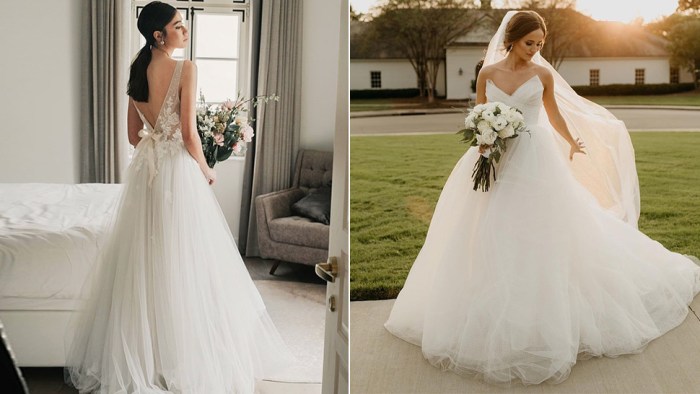Tulle Wedding Dresses: A Guide to the Fabric and its Applications: Wedding Dresses With Tulle
Wedding dresses with tulle – Tulle, a delicate and versatile fabric, adds an ethereal and romantic touch to wedding dresses. Its sheer nature allows for creative layering, draping, and embellishment, resulting in a wide array of stunning designs. This guide explores the various types of tulle, design elements, and stylistic applications to help you understand its role in creating breathtaking bridal gowns.
Types of Tulle Used in Wedding Dresses

Source: summitmedia-digital.com
The type of tulle used significantly impacts the final look of a wedding dress. Different tulles offer varying levels of stiffness, transparency, and texture. Soft tulle drapes beautifully, creating a flowing silhouette, while stiff tulle holds its shape better, ideal for structured designs. Embroidered tulle adds intricate detail and visual interest.
Several wedding dress silhouettes commonly incorporate tulle, including A-line, ballgown, mermaid, and sheath styles. The choice of tulle type complements the chosen silhouette, enhancing its overall aesthetic appeal.
| Tulle Type | Texture Description | Drape Characteristics | Suitability for Silhouette |
|---|---|---|---|
| Soft Tulle | Lightweight, delicate, and almost transparent | Flows easily, creating soft, romantic folds | A-line, ballgown, empire waist |
| Stiff Tulle | Firm, holds its shape well, less transparent | Maintains structure, creates defined layers | Ballgown, mermaid, structured A-line |
| Embroidered Tulle | Delicate tulle with added embroidery, varying textures depending on embroidery | Drape varies depending on embroidery weight, generally softer than stiff tulle | A-line, ballgown, sheath |
| Silk Tulle | Luxurious, slightly heavier than other tulle types, subtle sheen | Elegant drape, less prone to wrinkling | All silhouettes, particularly those requiring a more luxurious feel |
Design Elements Incorporating Tulle
Tulle’s versatility allows for diverse design techniques. Layering tulle creates volume and depth, while ruffles add texture and movement. Overlays of tulle can soften the look of other fabrics or add a touch of sheer elegance. The color and texture of the tulle greatly influence the overall aesthetic. A blush pink tulle evokes romance, while a crisp white tulle creates a classic look.
A textured tulle adds visual interest compared to a smooth one.
- Design 1: Romantic Ballgown: Soft tulle in ivory is layered to create a full, cascading skirt. Delicate floral embroidery adds subtle detail.
- Design 2: Modern Mermaid: Stiff tulle in champagne creates a structured mermaid silhouette. The tulle is overlaid with lace appliqués for a touch of sophistication.
- Design 3: Bohemian A-line: Layers of soft, blush-colored tulle create a flowing A-line skirt. The tulle is left unadorned for a simple, ethereal effect.
Tulle and Wedding Dress Styles, Wedding dresses with tulle
Tulle complements various necklines and sleeve styles. A sweetheart neckline paired with a tulle skirt creates a romantic look, while a halter neckline with tulle sleeves offers a more modern feel. Sleeveless styles showcase the tulle’s delicate nature, while long or short sleeves add structure and elegance.
- Sweetheart Neckline: Often paired with A-line or ballgown silhouettes, creating a classic and romantic look.
- Halter Neckline: Modern and sleek, often combined with fitted or mermaid silhouettes.
- Off-the-Shoulder Neckline: Romantic and flattering, tulle can create a flowing, elegant look.
- Sleeveless: Allows the tulle’s texture and drape to be the focal point.
- Long Sleeves: Adds a touch of drama and sophistication, often featuring intricate embellishments.
- Short Sleeves: A balance of elegance and modernity, offering various design options.
Tulle and Embellishments
Tulle is often enhanced with various embellishments, creating unique and visually stunning effects. Lace adds a touch of vintage charm, beading creates sparkle and shimmer, and sequins provide a glamorous touch. The choice of embellishment dramatically impacts the overall look and feel of the dress.
- Lace Appliqués: Adds intricate detail and a touch of vintage charm.
- Beading and Sequins: Creates sparkle and glamour, often concentrated in specific areas.
- 3D Floral Embellishments: Adds texture and visual interest, creating a unique and eye-catching design.
Illustrative Examples of Tulle Wedding Dresses

Source: dressedupgirl.com
Several examples showcase the diverse possibilities of tulle in wedding dress design.
- Dress 1: A fitted bodice accentuates the waistline, contrasting with a full, cascading skirt of soft ivory tulle. Delicate pearl beading adorns the bodice and trails down the skirt, adding subtle sparkle.
- Dress 2: Multiple layers of blush pink tulle create a dramatic cascading effect, the color deepening subtly from the bodice to the hemline. The soft tulle creates a romantic and ethereal silhouette.
- Dress 3: Delicate, off-the-shoulder sleeves crafted from tulle are overlaid with a delicate lace pattern, creating a play of textures and a touch of vintage elegance. The bodice is fitted, complementing the soft, flowing tulle sleeves and skirt.
Answers to Common Questions
How do I clean a tulle wedding dress?
Wedding dresses with tulle offer a romantic and ethereal look, perfect for brides seeking a touch of whimsical elegance. For brides in the Lees Summit area searching for their perfect gown, finding the right shop is crucial; consider checking out the selection at wedding dresses Lees Summit boutiques. Many offer a variety of styles, including those featuring the delicate and flowing beauty of tulle, ensuring you find the ideal dress to complete your fairytale vision.
Dry cleaning is generally recommended for tulle wedding dresses to prevent damage. Always check the care label for specific instructions.
Is tulle a durable fabric for a wedding dress?
Tulle’s durability varies depending on the type and weight. Heavier tulles are more durable than lighter ones. Proper care and handling are essential.
Can tulle be altered or taken in?
Yes, tulle can be altered, but it requires a skilled seamstress due to its delicate nature. Altering tulle may be more challenging than other fabrics.
How does tulle drape compared to other fabrics like satin or lace?
Tulle has a softer, more ethereal drape than satin, which is known for its sleekness. Lace, while often combined with tulle, has a more structured drape.
